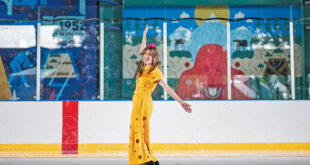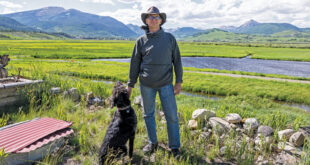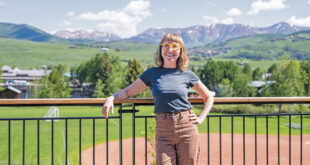Down-Homey Old Timey
by Dawne Belloise
There is no shortage of remarkably talented musicians in this valley and Crested Butte has spawned many excellent bands. Kevin Donovan is one of those local multi-instrumentalists who shines whether he’s laying down a funky Motown bass line or sliding the steel across the soulful down-homey sound of his dobro.
 Hailing from Podunk, N.Y., Kevin laughs, “People think it’s a joke but it’s real; it has no urban center, it’s more a state of mind,” he says of the small farming community about eight miles south of Ithaca. It was there, while in high school, that he took up guitar and later used his first paycheck from working at a chicken farm in Ithaca, the Cornell Experimental Turkey and Duck Farm, to buy his first bass guitar.
Hailing from Podunk, N.Y., Kevin laughs, “People think it’s a joke but it’s real; it has no urban center, it’s more a state of mind,” he says of the small farming community about eight miles south of Ithaca. It was there, while in high school, that he took up guitar and later used his first paycheck from working at a chicken farm in Ithaca, the Cornell Experimental Turkey and Duck Farm, to buy his first bass guitar.
“I took a month of classical guitar lessons from a teacher who studied with Segovia, and he wasn’t impressed with my technique. After that I went right back to Motown,” he grins.
Kevin grew up in a liberal, socialistic-leaning family. His father was a professor of industrial and labor relations at Cornell University, and his mother is a painter in mixed-media, nature-based, abstract art. “I was a happy kid. I was interested in playing in the woods and football. I learned to ice skate on the pond behind my house in those woods,” Kevin reminisces and adds, of course, that kids built forts, “Storing ammo for future campaigns against the neighbors. Crabapples and black walnuts were perfect projectiles to huck at the older neighbor kids.” He graduated from high school in 1969, a tumultuous era. “We’re talking the Vietnam War, the draft, and getting a student deferment,” he notes of the times.
Spending time in the woods was a big part of Kevin’s life, and he figured a life as a biologist would fit in nicely with his affinity for the outdoors, so after high school graduation he enrolled in Haverford College in Philadelphia, a Quaker school founded in 1832. It was an all-male student body but students could also take classes at Swarthmore College, where Kevin took all his biology courses.
In his junior year, he decided to take a field course and his biology advisor recommended Rocky Mountain Biological Laboratory (RMBL) in Gothic. It wasn’t his first choice and he came out to Colorado reluctantly because, he says, “The photo of the Wind River Range in Wyoming was far more attractive than RMBL’s pen-and-ink silhouette of a mountain.”
However, once he got to Crested Butte and stood under the magnificent spires of Gothic mountain, he fell in love. Kevin spent the summer studying field botany and ornithology. “Mostly, I felt that this was a great place and these were my people. He graduated in 1973 with a bachelors of science degree in biology.
Realizing he wasn’t going to get very far with his degree unless he furthered his education, Kevin began to think about graduate classes but he also knew he wanted to live closer to nature. Buying a new house wasn’t high on his list of life priorities, so instead, he took the alternative route many of the nature bound idealists of that generation followed—using his mom’s Singer sewing machine he sewed a teepee, loaded it into his old ‘65 Dodge pickup truck named Polk Salad, packed to the gills with his gear, his home-grown braided onions, zucchini and root vegetables, and headed back west to Gothic in the autumn of 1973.
“I was into Euell Gibbons (‘Ever eat a pine cone?’) at the time.” He recalls the allure of the 1960s back-to-the-land author. Kevin set up his teepee above Gothic, getting his water out of the creek and with billy barr as his neighbor across the road. He stayed until December 7, when they got snowed in. Packing up, he shipped his teepee poles back to New York for $17 and hit the road.
The following year, early in 1974, Kevin was introduced to Ossabaw Island off the Georgia coast, where he could do independent biological study and research as long as it involved the resources of the island. It was also an artist colony.
Kevin became the director for Project Genesis, hired by the woman who owned the island that she inherited from her family. She had established the 55-square-mile isle of dunes and tidal marshes as a hippie and artist colony, as well as for biological studies, where she mandated self reliance, communal living, and working together to live off the land.
Kevin says, “People would typically stay there one to four months to do their projects, like learning timber framing or the nesting behavior of egrets.” He was there full-time for a year and then involved with various projects, off and on, for seven years. His research project revolved around the effect of herbivore grazing on dune structure.
At the same time, he began to learn construction, because he realized he had to make a living and he found the art of working with his hands to be enjoyable. He had determined that going back to school wasn’t an option for him.
The winter of 1976 found Kevin back up in Gothic, living in a little tent with only a stove for heat and studying Spanish with a plan to hitchhike from Crested Butte to Guatemala. “There had been an earthquake in Guatemala while we were in Mexico,” Kevin says. “We were invited by a friend from Ossabaw to go to Guatemala to help rebuild after the earthquake damage.”
He and a girlfriend ended up building temporary shelters and storehouses for the aid donations. “It was an intense experience. I had never been in a disaster area. There was not one adobe left standing in a city of 10,000 people and 20 percent of the population died.” Kevin stayed for three months as a volunteer, after which, he decided, “All I really wanted to do was have my own place and grow spinach. My college buddy had an old farmhouse that he was renting in Rockbridge County, Virginia. For $12.50 per month, per person, for eight years, we lived on 100 acres, with nine barns and a swimming hole. We had awesome gardens, made our own maple syrup, and grew shiitake mushrooms. That’s when I started building, working for other people. My apprenticeship was short. I went out on my own when someone offered me a job to build an octagonal cabin. I did everything—electric, plumbing, built a stone chimney. I had to learn it all.”
During his communal farm days, Kevin also became a lab instructor in chemistry and biology at Southern Seminary Junior College for Women, and he started playing more music.
Kevin felt there was a connection between his hometown of Ithaca’s old-time string bands and the old-time musicians of Rockbridge County. Both were small communities interested in non-main stream, generally unpopular music.
“And they get kind of fanatic about it,” he laughs. “They know they’re not mainstream and they don’t want to be. People out here [in Colorado] will call anything with a wooden guitar and a fiddle bluegrass music, but there, old-time string music is a separate genre. When you’re at a festival where both genres are represented, you’ll see that the bluegrass camping area has the hard glare of the Coleman lanterns as opposed to old-timers who are playing by a candle or in absolute dark.”
He naturally progressed to dabbling in the fringes of old-time music when he got to Virginia. To mix it up, Kevin also played bass in a rock and rock cover band for a short time, but the late nights weren’t conducive to his construction work or farm life. What he found more inspirational was the home jam circles with bluegrass and old-timey musicians. “I was coming to Colorado and going to the Rocky Grass Music Academy run by Planet Bluegrass in Lyons for a week, for several years,” he says. His technique exploded exponentially, as did his love of that genre.
For several summers starting in 1980, Kevin worked for RMBL’s building projects and then he met Sonda Eastlack, who was also working there. “We hit it off immediately. She eventually came to Virginia, and said, ‘Nice place to visit but I don’t want to live here,’ at the same time I was thinking the same thing about Gunnison County. I liked what I had in Virginia. There was more of the original culture in Virginia. I liked the mild climate, the rivers were warmer and I’m a child of deciduous forests,” Kevin says, and he had his 30 acres with a little cabin there.
Sonda took a job in Virginia and moved there in 1994, but they moved back to Crested Butte the following year because Kevin realized that he’d rather live in Crested Butte with Sonda than anywhere else without her. They married in 1996, their daughter, Ella, was born in 1997 and Corinna came along in 2000. Eventually Kevin started his own construction company, Mo’ Bettah Builders, with the name from the James Michener novel Hawaii.
“When we got married, Sonda bought me a dobro. I had heard Sally Van Meter backing up a vocalist at the Telluride Bluegrass Fest and just loved the way the dobro complemented the human voice,” Kevin says. He took lessons at Rocky Grass again and began playing Americana genre around the valley, mostly in jam circles, weddings and funerals.
“It seemed like every gig was a different assemblage of musicians and I do like that. I like the democracy of bluegrass music. In a jam circle, everybody gets to choose a song, everybody gets a turn in the circle. When it comes to instrumental solos, everybody gets a chance and you’re encouraged to take one. I find the Colorado bluegrass community very supportive… as long as you don’t play too loud and can keep the damn beat,” he laughs. “I would always like to play more than I do. It’s one of the most satisfying things that I do. There’s not much substitute for playing good music with other people. For me, it’s about the group, it’s not about playing solo. Besides the dancing and laughing and having a good time, the most special thing to me is playing emotional music where the band is locked together and if there is an energy reciprocity between musicians and audience, it becomes a more spiritual thing and that’s where I want to be. Harmony singing can get you there quicker. There’s something about the resonance between human voices that can touch your soul quicker than anything.”
 The Crested Butte News Serving the Gunnison Valley since 1999
The Crested Butte News Serving the Gunnison Valley since 1999




